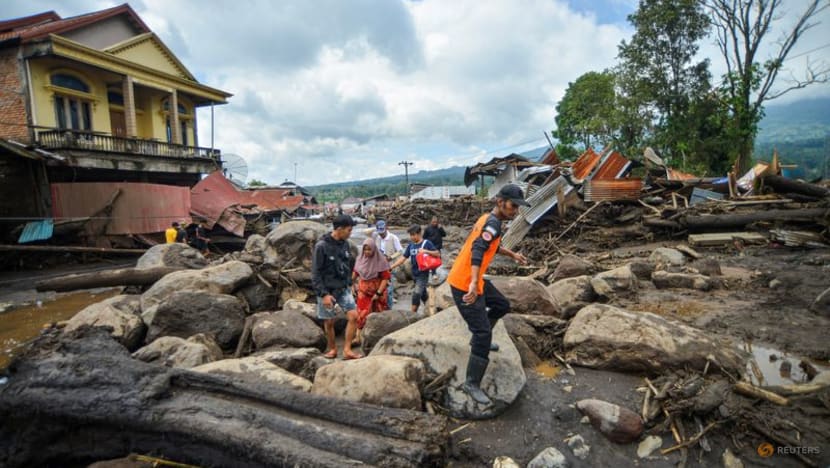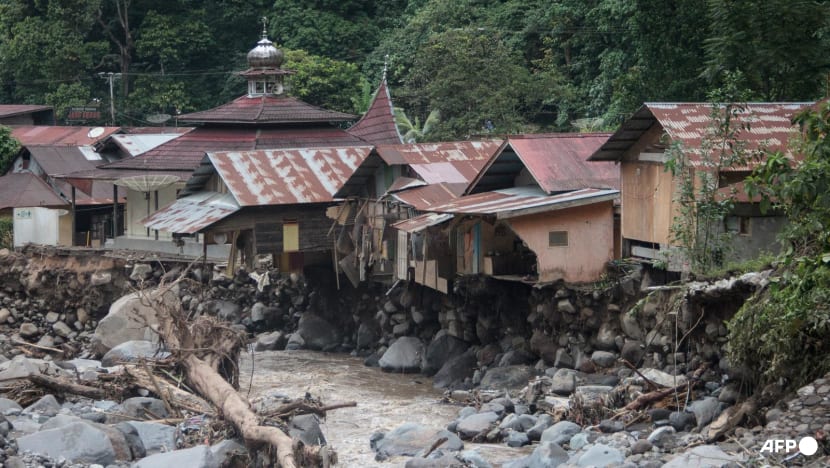67 killed in Indonesia’s cold lava, flash floods: Experts say deaths were avoidable, warn of further surges
The floods also knocked down bridges, cut off roads and buried farmlands and residential areas under thick layers of mud and debris.


This audio is generated by an AI tool.
JAKARTA: Deaths from cold lava and flash floods on Indonesia’s Mount Marapi could have been avoided, say experts, who urge residents living on the slopes of Sumatra’s most active volcano to be better prepared against natural disasters.
As well as evacuation routes, they add that weather modification techniques and better land use policies at provincial government level could help mitigate risks brought on partly by overdevelopment and deforestation.
On Saturday (May 11) evening, heavy floods, triggered by dozens of eruptions over the past five months, swept away tonnes of volcanic ash which had accumulated on the slopes of the mountain to the valleys and rivers below.
Surges of cold lava, water and rock flowed down multiple sides of the volcano, which takes its name from the local Minang phrase for “Mountain of Fire.”
The floods, which affected virtually all of the two dozen rivers with headwaters on Mount Marapi, were so powerful they knocked down bridges, cut off roads and buried farmlands and residential areas under thick layers of mud and debris.
By Wednesday morning, 58 people were confirmed dead and 35 more were missing due to the flash floods.
Later in the afternoon, Indonesia's disaster agency chief said the death toll had risen to 67 while some of those missing had been found.
Officials from the Indonesian Volcanology and Geological Hazard Mitigation Centre (PVMBG) had been warning residents for months that with so much volcanic material accumulating near Marapi’s crater, rainfall could potentially lead to a flash flood.
They had raised the alarm shortly after Dec 3, when 23 hikers were killed in a Marapi eruption. The climbers had ignored a government warning to stay at least 2km from the volcano’s crater, which has been in place since 2011 when the mountain showed signs of increased volcanic activity.
The centre had also issued a map of where the likely flood-affected areas would be.
Meanwhile, the Indonesian Meteorology, Climatology and Geophysics Agency (BMKG) has been warning residents that heavy showers could hit the areas around the volcano, from May 6 until May 22.
But despite these warnings, residents did not stay clear of riverbanks when rain hit the volcano for hours on May 11.
“Warnings about the risk of flash floods had been issued for quite some time. There is even a map of where the flash flood will affect. Deaths should have been avoided,” Dr Eko Teguh Paripurno, a disaster mitigation expert from Yogyakarta’s National Development University (UPN) told CNA.

DEFORESTATION ALSO TO BLAME
Overdevelopment and deforestation on Mount Marapi as well as along the riverbanks also contributed to the severity of the disaster, said Indonesian National Disaster Mitigation Agency (BNPB) spokesman Mr Abdul Muhari.
“Ten years ago, (riverbanks) were still covered by large trees, which meant that even if there is an extensive rise in water debit, the water will not erode the cliffs’ edge,” the spokesman said in a press conference on Monday.
Mr Muhari noted that despite the potent danger of cold lava and flash floods, riverbanks near Mount Marapi continued to be developed into residential, commercial and recreational areas.
Two riverside waterparks, Mega Mendung and Mata Air, as well as a restaurant called Xakapa in Silaiang district, around 15km southeast of Marapi’s crater, were completely obliterated by the floods.
Hundreds of houses, as well as schools and mosques in two regencies, Tanah Datar and Agam, were either damaged or completely swept away by the sudden water surge. The floods also destroyed bridges and cut off major roads connecting some of West Sumatra province’s important cities.
The BNPB is still calculating how much damage the floods cost.
Vulcanologist Dr Surono said it is time for the West Sumatra government to rethink its land use policies.
“Marapi frequently erupts. It constantly ejects a lot of (volcanic) material. Cold lava flash floods are common. People shouldn’t be living so close to the rivers,” Dr Surono, who like many Indonesians goes by one name, told CNA.
Chief of Indonesia’s meteorology agency, Professor Dwikorita Karnawati said her office predicts more rain will hit West Sumatra over the next week.
“The rain does not need to be heavy. Even a moderate one is capable of washing away volcanic material from Mount Marapi of which we fear there is still a lot,” she said on Tuesday as quoted by Indonesian news agency, Antara.
Prof Dwikorita said another water surge could impact previously unaffected areas as the rivers are now filled with thick layers of mud and debris from Saturday’s floods.
The BMKG chief also suggested cloud seeding, a weather modification technique that improves a cloud’s ability to produce rain. Cloud seeding, she said, can be used to force rain to fall on safer, low-lying areas along West Sumatra’s coasts instead of the upper slopes of Marapi.
DISASTER PREPAREDNESS IS KEY
This is not the first time West Sumatra has been affected by such a devastating cold lava flash flood.
In the early hours of Apr 30 1979, 60 people were killed and 19 more went missing when the rivers surrounding Mount Marapi were overwhelmed with fast-moving water infested with huge rocks and debris from high up the mountain. The floods were preceded by an eruption and heavy downpour just hours before.
Since then, nearly all Marapi eruptions have been followed by a series of cold lava flash floods.
The Dec 3 eruptions have triggered four flash floods, local media reported, although none were as devastating as the one on Saturday.
“Flash floods are so common the people of West Sumatra have a word for it: galado,” Dr Surono said. “It is time for those living close to the riverbanks to truly understand the risks (of living in such areas) as well as know how to mitigate them.”
Dr Surono highlighted how communities in other active volcanoes across Indonesia had set up a network of hand-held radio transceivers to inform one another of any potential danger.
“That’s how people working on the rice fields know that there is an eruption. That’s how people mining for sands on the riverbed know that a flash flood is coming,” he said.
Residential areas, the vulcanologist said should also have clearly marked evacuation routes while their inhabitants should be properly trained on what to do in the face of a possible disaster.
Dr Eko of UPN Yogyakarta echoed the sentiment.
“Everyone needs to work together to improve people’s disaster preparedness, because cold lava floods not only affect those living close to the mountain,” he said.
“People need to know how to respond (to an incoming disaster) and understand when and where to evacuate. If not, then there will surely be more victims the next time a disaster hits.”
















